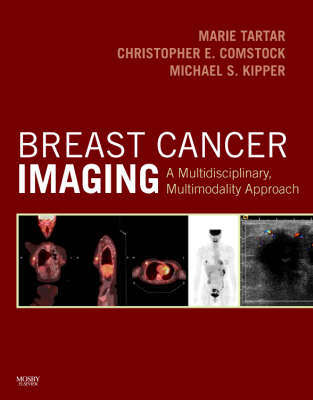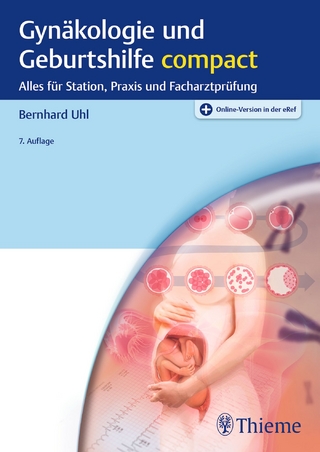
Breast Cancer Imaging
Mosby (Verlag)
978-0-323-04677-0 (ISBN)
- Titel ist leider vergriffen;
keine Neuauflage - Artikel merken
Through a case-based approach, this book illustrates the best practices for all facets of breast cancer imaging - from screening of asymptomatic patients to cancer staging, identifying metastases, and assessing efficacy of treatment - in a succinct, practical source. Contributing authors from a wide range of subspecialties provide well-rounded guidance to meet the needs of today's multidisciplinary work environment.
Chapter 1: Screening for breast cancer in asymptomatic patients by Chris Comstock, MD and Marie Tartar, MD Case 1: Breast cancer presenting as a small new mass on mammography Case 2: Breast cancer presenting as a new mass on mammography Case 3: Breast cancer presenting as a new spiculated mass on mammography Case 4: Breast cancer presenting as a small growing mass in the axilla Case 5: IDC presenting as a small growing mass Case 6: Small growing breast cancer presenting as a contour change on mammography Case 7: Breast cancer presenting as a largely obscured mass in dense breast tissue Case 8: Slowing growing microlobulated colloid carcinoma (benign looking growing mass) Case 9: Breast cancer presenting as a new posterior mass on mammography: importance of inclusion of posterior breast tissue on mammography Case 10: DCIS presenting as a microcalcification cluster Case 11" DCIS presenting as multiple microcalcification clusters along a ductal ray Case 12: Breast cancer presenting as architectural distortion in extremely dense breasts Case 13: ILC presenting as growing amorphous density Case 14: Small cancer in implant patient, well seen only on implant displaced views Case 15: Importance of complete work-up of new mammographic masses Case 16: MRI high risk screening for occult breast cancer Case 17: MRI high risk screening for occult breast cancer Case 18: Breast cancer presenting as a growing small mass on screening MRI Case 19: CT identification of unknown breast cancer in an asymptomatic patient Case 20: PET identification of occult breast cancer in an asymptomatic patient Chapter 2: Evaluation of the symptomatic patient: Diagnostic breast imaging Cases: 1. Palpable axillary IDC, presenting as a growing mammographic mass simulating a lymph node 2. Palpable lump presenting as malignant microcalcifications on mammography 3. Palpable IDC presenting as mammographic architectural distortion and shadowing sonographic mass 4. Palpable ILC presenting as architectural distortion 5. Palpable lump presenting with masses and pleomorphic microcalcifications 6. Palpable lump presenting as mammographic architectural distortion with microcalcifications 7. Palpable lump presenting as growing amorphous mammographic asymmetry 8. Palpable lump presenting as developing mammographic density 9. Mammographically occult palpable breast cancer 10. Large, palpable, mammographically occult invasive carcinoma 11. Breast cancer involving the nipple-areolar complex, not identified on conventional imaging, demonstrated by MRI 12. Mammographically occult retroaerolar breast cancer presenting as nipple retraction 13. Importance of clear communication and accurate history; Inaccurate history of biopsy "scar" leads to near-miss of a spiculated cancer 14. Axillary nodal presentation of breast cancer, primary found on MRI 15. Axillary nodal presentation of ILC, occult on conventional imaging, primary found by MRI 16. Axillary nodal presentation with negative mammogram, primary found on PET 17. Axillary nodal presentation with initially negative mammogram, medial primary found on CT 18. Male breast ca 19. Male breast ca 20. Male breast cancer and gynecomastia 21. Male breast cancer with microcalcifications 22. Male breast cancer with skin thickening and nipple enlargement Chapter 3: Local staging: Imaging options and core biopsy strategies By Christopher Comstock, MD and Marie Tartar, MD Cases:1. Mammography: extent of disease 2. Ultrasound: extent of disease 3. Use of US to find invasive disease within extensive microcalcifications, depiction of disease extent by breast MRI vs. PEM vs. whole body PET 4. Multi-focal breast cancer, first identified on abdominal CT, radiologic "corner shot" 5. MRI: extent of disease 6. MRI: extent of disease 7. MRI: extent of disease (Tip of the iceberg detected on mammography) 8. MRI: extent of disease (Multi-focal disease, dense breasts) 9. Multi-centric IDC and DCIS: Local staging with MRI 10. Additional disease site identified by PEM 11. Breast cancer presenting with axillary node involvement by mammography and US 12. Subtle axillary nodal involvement 13. Breast MRI problem solving: Deciding among sites for additional sampling 14. Breast MRI problem solving: Assessing depth of involvement of posterior breast cancer 15. Breast MRI problem solving: Chest wall invasion 16. Breast MRI problem solving: positive margins post- lumpectomy, assessment for residual disease 17. Breast MRI problem solving: MRI guidance for tailored lumpectomy 18. Breast MRI problem solving: assessment of completeness of breast cancer excision 19. Contralateral DCIS found by staging breast MRI 20. Contralateral breast carcinoma found on MRI, not seen on second-look ultrasound 21. Contralateral breast carcinoma found on MRI, not seen on second-look ultrasound 22. Evaluation of the other breast with MRI 23. Use of body coil STIR imaging for staging new dx of BC 24. MRI depiction of axillary and internal mammary node involvement 25. Cautionary notes on the use of breast MRI: 26. Cautionary notes on the use of breast MRI: 27. Whole body PET as an adjunct to initial staging of node+ breast cancer: Benign PET pelvic uptake in a corpus luteum cyst 28. Whole body PET as an adjunct to initial staging of node+ breast cancer: Rotter node involvement 29. Bracketing needle localization of microcalcifications 30. Medial breast cancer with internal mammary drainage on lymphoscintigraphy 31. Biopsy quality control: Mammographic lesion, discordance with pathology results 32. Biopsy quality control: Mammographic lesion, wrong US correlate biopsied, rationale for post US biopsy clip placement and mammogram 33. Biopsy quality control: DCIS presenting as disappearing microcalcifications and subsequent development of a mass Chapter 4: Unusual and Problem Types of Breast Cancers: DCIS, Intracystic papillary carcinoma, Benign-looking breast cancers, ILC, inflammatory breast cancer, and breast cancer in implant patients By Christopher Comstock, MD and Marie Tartar, MD Cases: 1. DCIS, calcified and non-calcified 2. Extensive intraductal carcinoma presenting as a palpable, tumor-filled ductal system 3. BRCA-1 patient, abnormal whole body PET leading to diagnosis of DCIS 4. Intracystic papillary carcinoma 5. Intracystic papillary carcinoma 6. Colloid cancer, 2 cases 7. Medullary cancer, question of liver metastases on breast MRI; FDG uptake on PET in a fibroid 8. Bilateral breast carcinomas on 18F-FDG positron emission tomography 9. ILC 10. ILC presenting with orbital metastasis, bilateral shrinking breasts 11. ILC presenting as a mass, post-operative changes on CT and PET 12. ILC presenting as architectural distortion 13. ILC presenting as a palpable, predominantly hyperechoic ultrasound mass 14. Echogenic breast cancer 15. ILC treated with neo-adjuvant chemotherapy 16. Stage IV ILC, presentation with liver metastases 17. US findings of inflammatory cancer 18. Inflammatory breast cancer in a lactating patient 19. Initial identification of breast cancer during breast MRI for implant integrity 20. Multi-focal IDC in a patient with implants and dense breasts 21. Large, locally advanced IDC in implant patient Chapter 5: Locally Advanced Breast Cancer (LABC) and Neo-adjuvant Chemotherapy by Marie Tartar, MD; Christopher Comstock, MD; and Michael Kipper, MD Cases: 1. LABC (large tumor size) 2. LABC with axillary and internal mammary involvement, staging with whole body PET and PEM 3. LABC with nipple skin involvement 4. Natural history of untreated inflammatory breast cancer 5. LABC with secondary inflammation (secondary IBC) 6. PABC, treated during pregnancy with neo-adjuvant chemotherapy with complete pathologic response 7. Post-partum LABC, with multiple axillary nodes involved, excellent response to neo-adjuvant chemotherapy 8. IDC treated with neo-adjuvant chemotherapy with incomplete imaging response, but complete pathologic response 9. LABC, responsive to neo-adjuvant chemotherapy; splenic activation with G-CSF therapy 10. Complete imaging response to neo-adjuvant chemotherapy 11. IDC with cystic component, mixed response to neo-adjuvant chemotherapy 12. LABC, unresponsive to neo-adjuvant chemotherapy 13. Rapidly progressive inflammatory breast cancer, unresponsive to chemotherapy 14. LABC, good response by imaging to neo-adjuvant chemotherapy, but significant residual pathologic disease; imaging-guided tailored lumpectomy Chapter 6: Locally recurrent disease: Imaging surveillance Cases: 1. Post-operative scar with hematoma on MRI 2. Changes from recent bilateral mastectomy and tissue expander placement 3. Normal CT appearance of bilateral TRAM flap reconstruction and post-TRAM flap abdominal complications 4. Recurrent DCIS presenting as new microcalcifications 5. Recurrent DCIS detected on surveillance MRI 6. ADH/DCIS found on breast MR obtained to evaluate silicone implant integrity in BCT patient 7. New palpable chest wall lump post mastectomy with implant reconstruction, excisional biopsy proven recurrent IDC 8. Axillary recurrence (new soft tissue around axillary lymph node dissection clips), presentation with pain 9. Parasternal recurrence, draining to contralateral axilla (role of lymphoscintigraphy) 10. Multicentric recurrent breast cancer with skin involvement 11. Physical examination change and abnormal enhancement of a 4 yr old lumpectomy scar, pathology proven fat necrosis mimicking tumor bed recurrence 12. Enhancing scar, suspicious for recurrence; contralateral axillary nodal presentation of new occult breast primary 13. Proven multi-centric fat necrosis mimicking multi-centric recurrence 14. TRAM flap recurrence on mammography 15. Residual carcinoma in TRAM flap reconstructed neo-breast 16. TRAM flap reconstruction with fat necrosis and supraclavicular lymphadenopathy, simulating recurrent disease 17. Chest wall recurrence detected on surveillance MRI 18. Recurrent IDC and radiation-induced pleomorphic sarcoma, with chest wall invasion Chapter 7: Breast cancer mimics By Christopher Comstock, M.D. and Marie Tartar, M.D. Case 1. Papilloma presenting with bloody nipple discharge, ductogram and ultrasound Case 2. Multiple papillomas Case 3. Small phylloides tumor Case 4. Large phylloides tumor (ultrasound) Case 5. Large phylloides tumor Case 6. Multifocal breast abscesses Case 7. Granulomatous mastitis Case 8. Lymphocytic mastitis Case 9. New fat necrosis mass mimicking recurrence Case 10. Fibrosis mimicking recurrence in implant reconstructed breast cancer patient Case 11. Lactational asymmetry on PET Chapter 8: Bone metastases By Michael Kipper, M.D. and Marie Tartar, M.D. Cases: 1. Stage IV presentation of breast cancer with bone metastases 2. Stage IV presentation with bone metastases (breast cancer presenting with back pain) 3. Relapse with bone metastases 4. Progression of bone metastases, epidural extension, radiation therapy effects 5. Recurrence with bone metastases: disease extent discordant between imaging and bone scan, pathologic fractures 6. Diffuse bone metastases, underrepresented on bone scan. 7. Recurrence with mediastinal lymphadenopathy, vocal cord paralysis and sclerotic bone metastases 8. Significance of solitary rib activity on bone scan, chemotherapy-related marrow activation changes on PET 9. Significance of solitary rib activity on bone scan 10. Solitary sclerotic rib metastasis (positive on bone scan, negative on PET) 11. Assessing activity of sclerotic bone metastases 12. Diffuse bone metastases (superscan) 13. Radiation therapy effects on bone 14. Extensive bone metastases, F-18 bone scan Chapter 9: Liver Metastases By Marie Tartar, M.D. Cases: 1. Work-up of indeterminate liver lesion with MRI (hemangioma) 2. Progression liver metastases on CT and PET 3. Pseudocirrhotic appearance of treated breast liver metastases, mislocalization of right liver metastasis into right lung base on PET/CT 4. Progressive liver mets on CT & PET 5. Liver metastases arising in fatty liver, better seen on CT than PET 6. Evolution of liver metastases with treatment to unusual cyst-like residual Chapter 10: Thoracic metastases, mimics and treatment effects By Marie Tartar, M.D. and Michael Kipper, M.D. Cases: 1. Solitary pulmonary nodule in the breast cancer patient: primary lung cancer vs. breast cancer metastasis. 2. Lung metastases, progression to pleural metastases 3. Chest wall, pleural and thoracic nodal recurrence 4. Pleural recurrence-bone scan and CT findings 5. Pleural and chest wall recurrence 6. CT and PET findings of talc pleurodesis for malignant pleural effusion 7. Infraclavicular and mediastinal nodal recurrence presenting with brachial plexopathy symptoms 8. Brachial plexus involvement 9. Atlas case 12 (chest wall and lung recurrence) 10. Atlas case 16 (nodal recurrences to mediastinum and supraclavicular regions) 11. PET+ thoracic nodal recurrence mimic due to silicone implant leak 12. Unusual pattern of chest wall recurrence (intercostal muscle infiltration) 13. Drug reaction (pulmonary toxicity) due to chemotherapy 14. Lymphangitic tumor 15. Lymphangitic tumor Chapter 11: Breast cancer metastases to the neural axis By Marie Tartar, M.D. and Steven S. Eilenberg, M.D. Cases 1. Multilocular thalamic cystic metastasis 2. Brain metastases mimicking multiple sclerosis 3. Brain metastases mimicking multiple sclerosis 4. Brain metastases identified on PET in asymptomatic metastatic breast cancer patient 5. Unusual "miliary" pattern of brain metastases 6. Dural based sphenoid wing metastasis with orbital extension 7. Plaque-like dural metastases 8. Skull metastases with extra- and intracranial extension 9. Skull metastasis and chemotherapy-induced leukoencephalopathy 10. Recurrent brain metastasis, radiation-induced leukoencephalopathy 11. Spinal leptomeningeal carcinomatosis Chapter 12: Multi-system and unusual systemic metastases: Imaging assessment of treatment response, By Michael Kipper, M.D. and Marie Tartar, M.D. Cases: 1. Recurrent PET+ activity in LABC & bone mets with increased tumor markers 2. Gastrointestinal metastases from breast cancer 3. Peritoneal breast carcinomatosis 4. Bone, liver, pericardial and ovarian metastases Chapter 13: Radiation Therapy By Eva Lean, Ray Lin, Marie Tartar Case 1. Utility of Pre-Radiation Mammography Case 2. Dramatic radiation therapy changes of breast on mammography and MRI Case 3: 2 Month Old Radiation Therapy Effects on Lung (CT and PET) Case 4: Breast Cancer Radiation Induced Lung Changes on CT and PET Case 5: Typical apical change from supraclavicular radiation therapy on CT, MRI, and PET Case 6: Mass-like apical radiation fibrosis Case 7: Early post-radiation changes on breast MRI Case 8: Late post-radiation changes on breast MRI Case 9: Radiation-induced angiosarcoma
| Erscheint lt. Verlag | 1.8.2008 |
|---|---|
| Zusatzinfo | Approx. 1620 illustrations (950 in full color) |
| Verlagsort | St Louis |
| Sprache | englisch |
| Maße | 216 x 276 mm |
| Themenwelt | Medizin / Pharmazie ► Medizinische Fachgebiete ► Gynäkologie / Geburtshilfe |
| Medizin / Pharmazie ► Medizinische Fachgebiete ► Onkologie | |
| Medizin / Pharmazie ► Medizinische Fachgebiete ► Radiologie / Bildgebende Verfahren | |
| ISBN-10 | 0-323-04677-0 / 0323046770 |
| ISBN-13 | 978-0-323-04677-0 / 9780323046770 |
| Zustand | Neuware |
| Haben Sie eine Frage zum Produkt? |
aus dem Bereich


